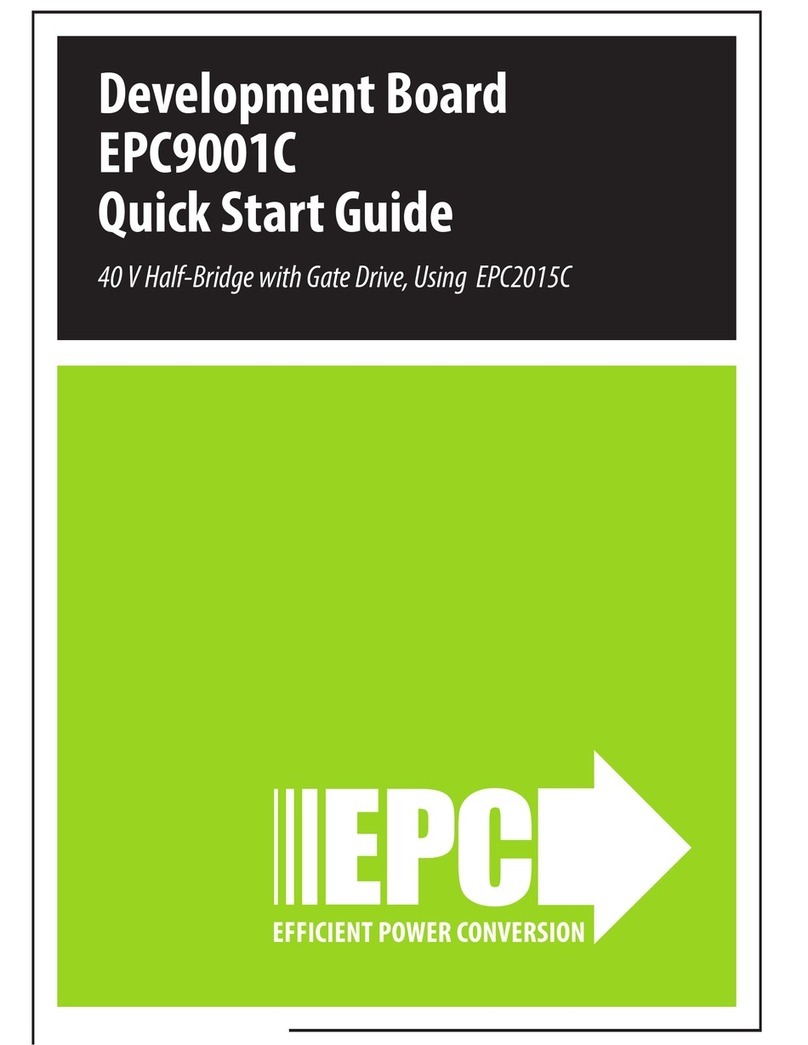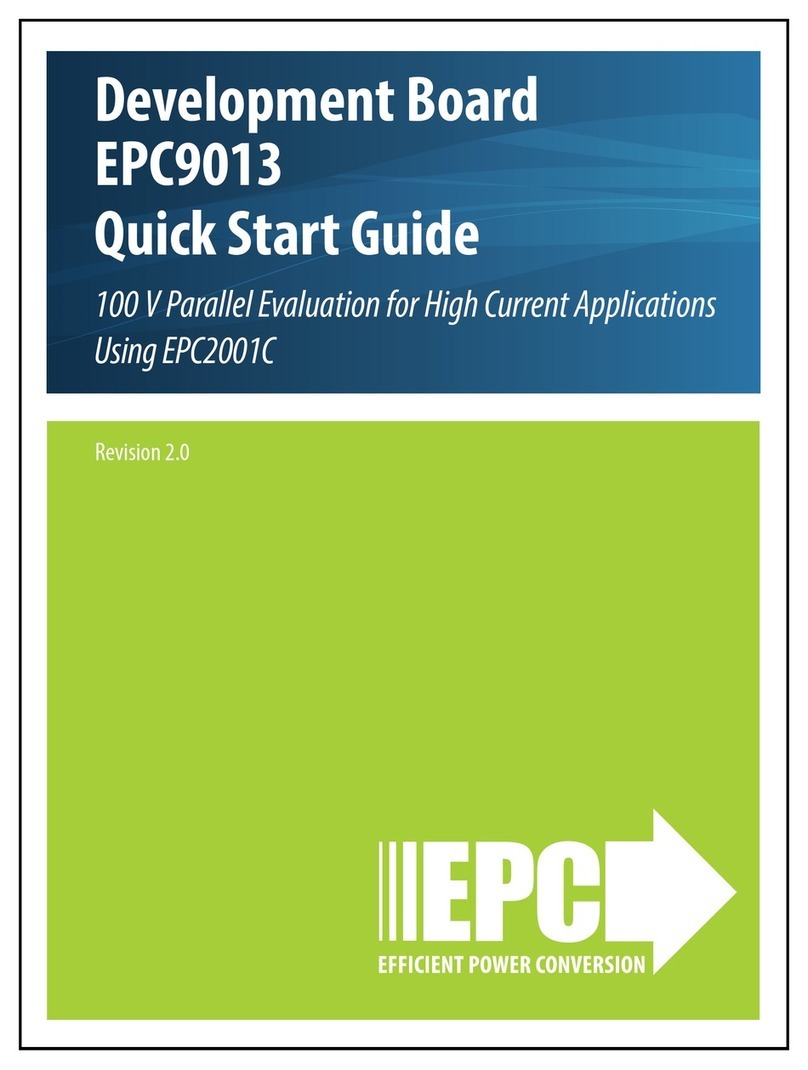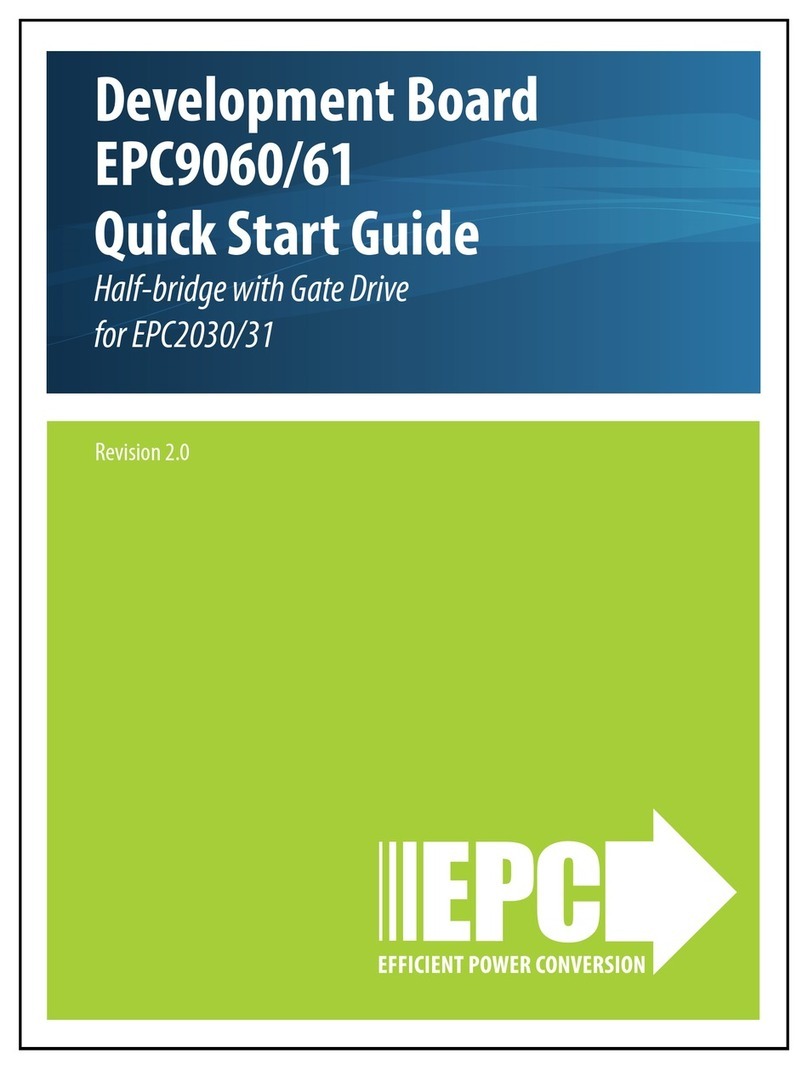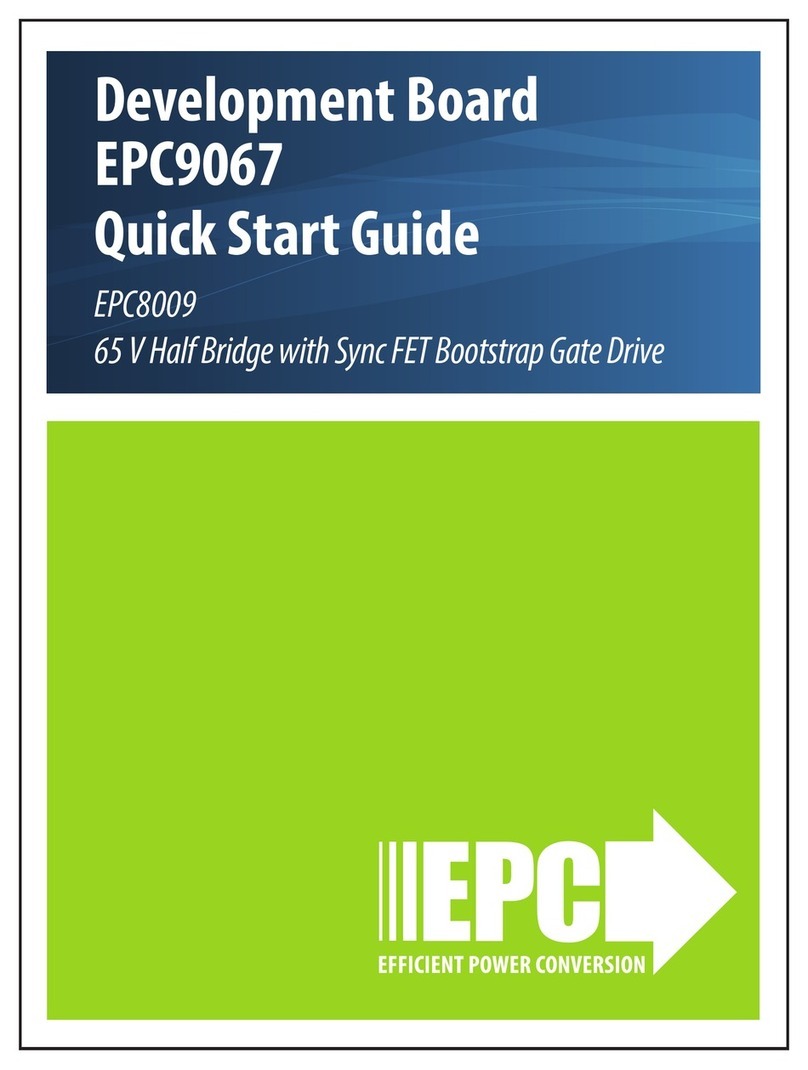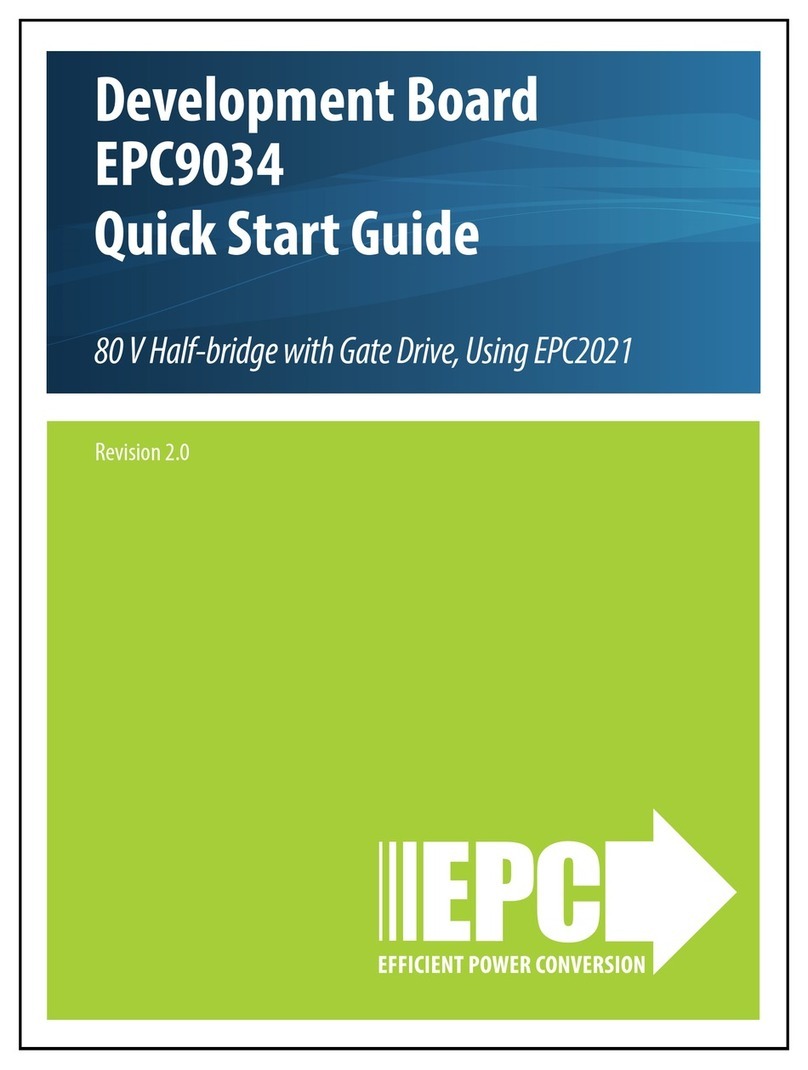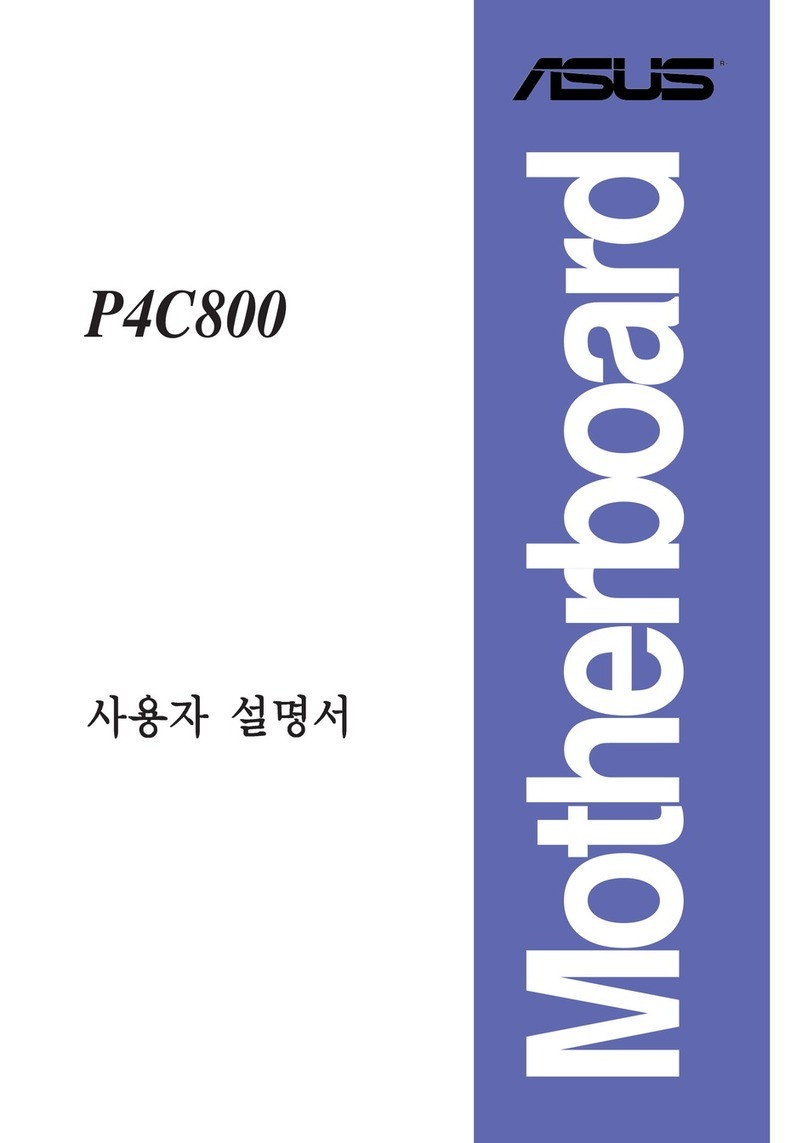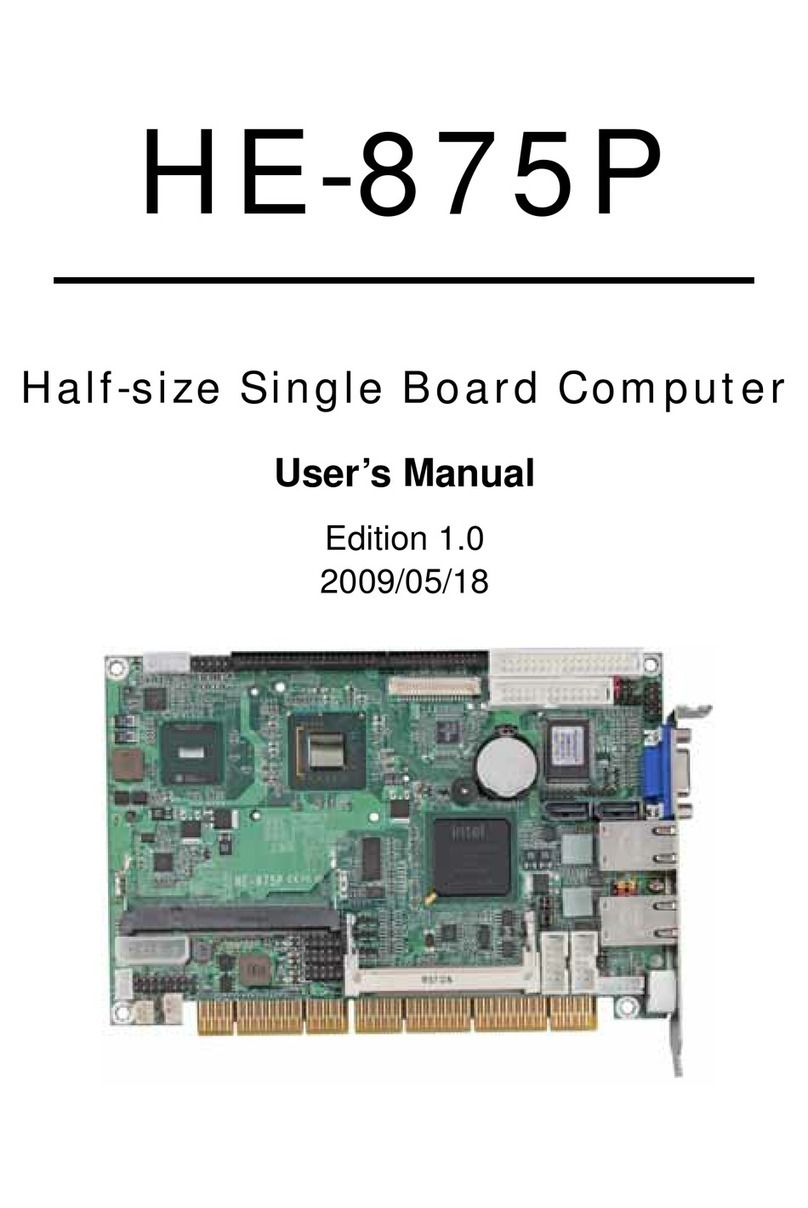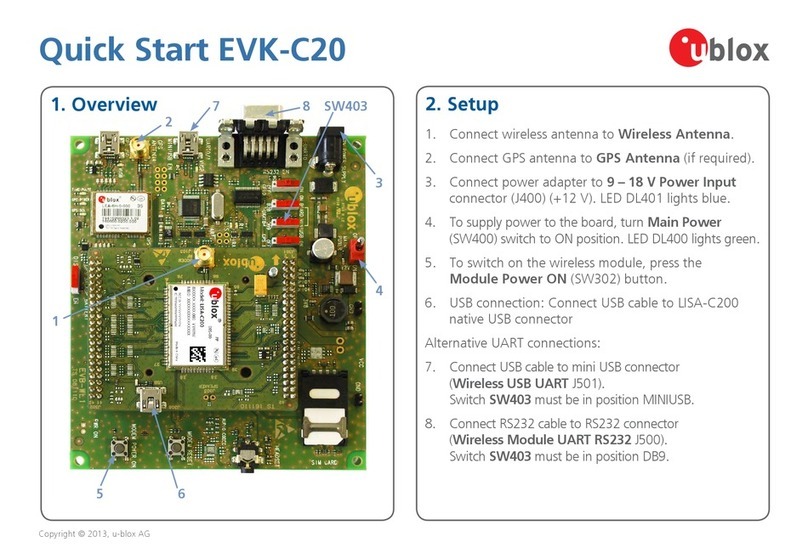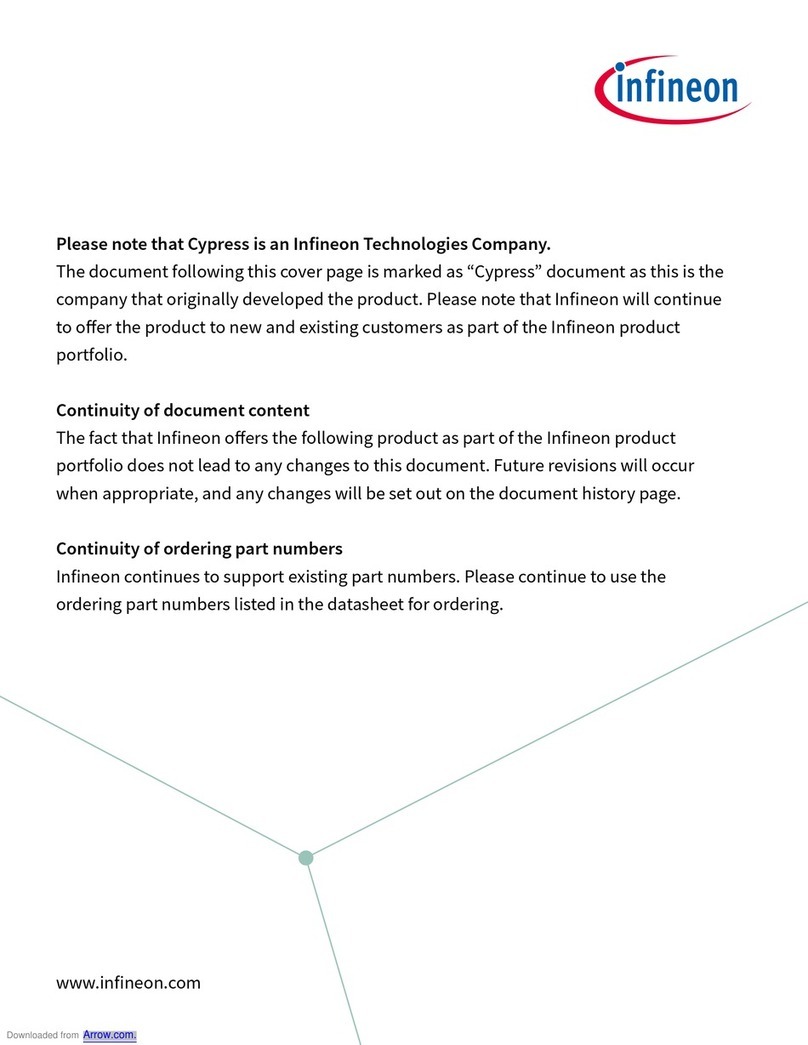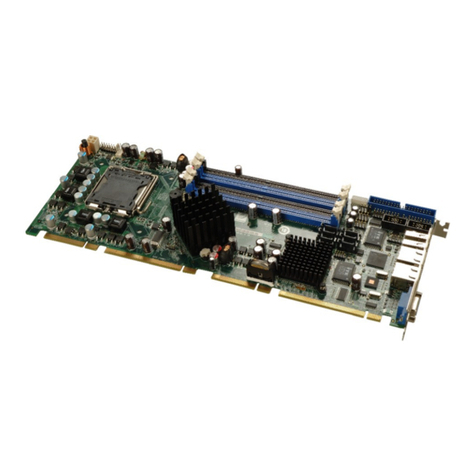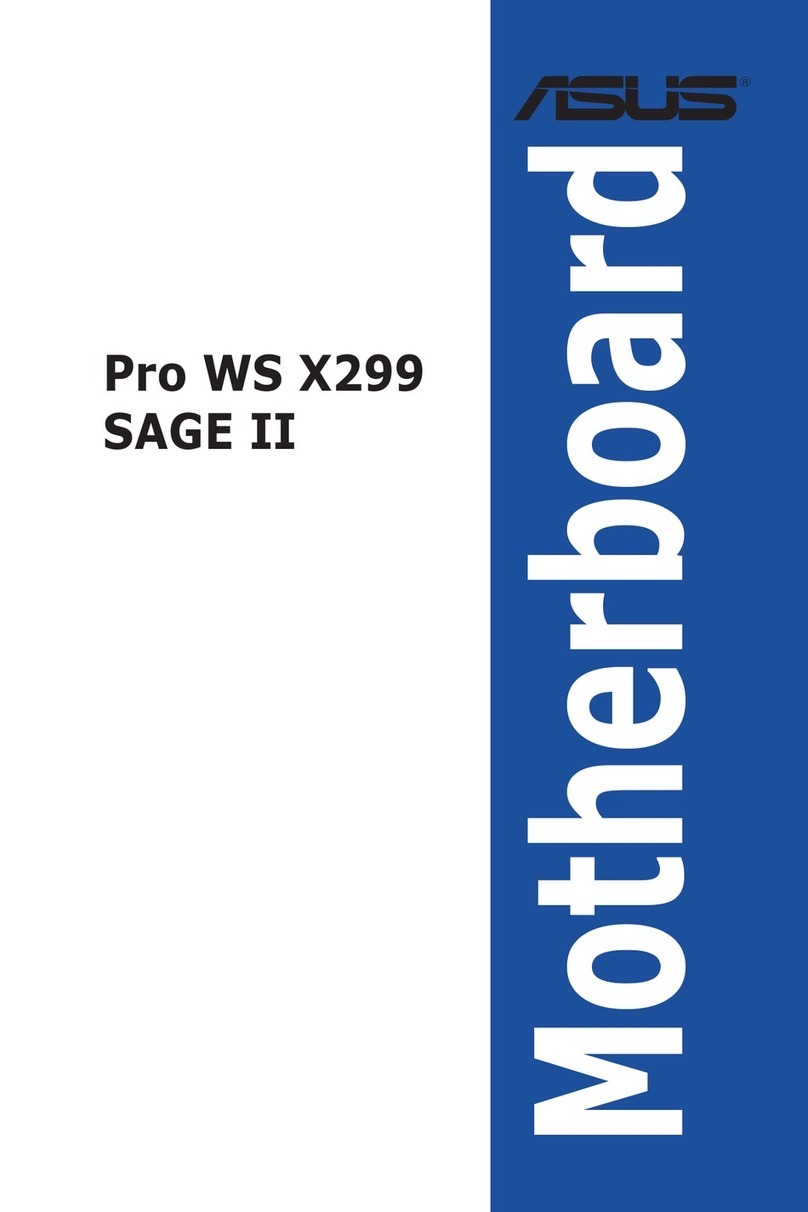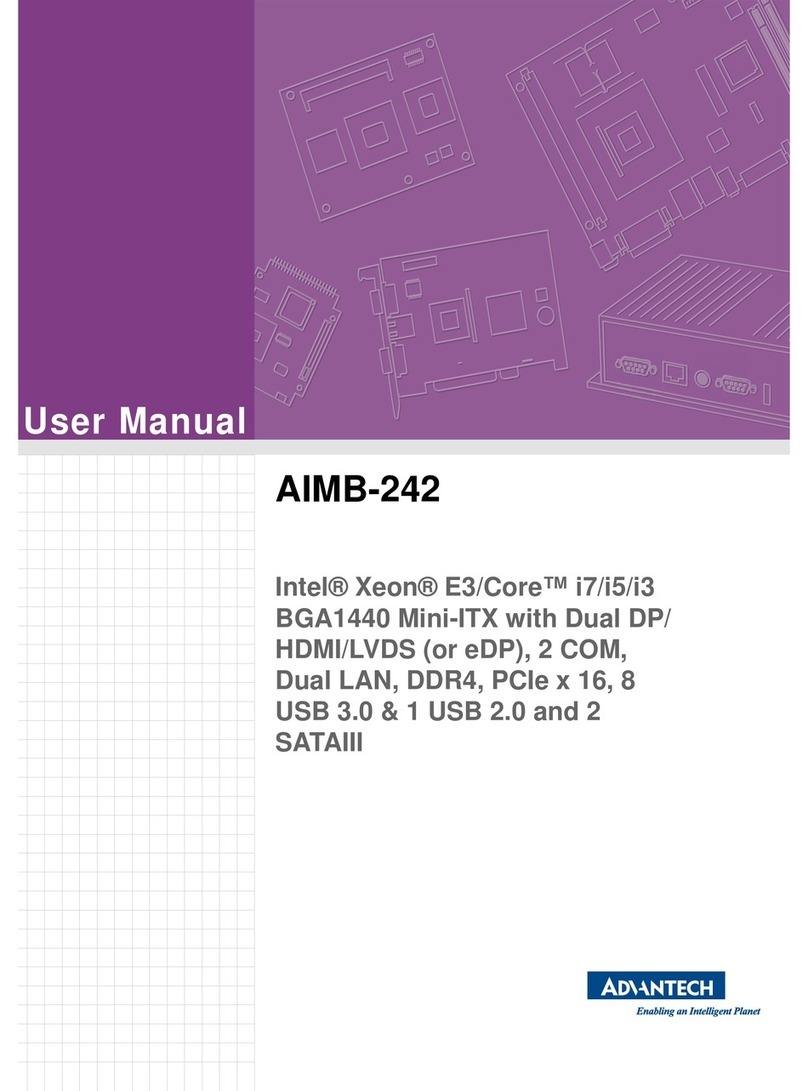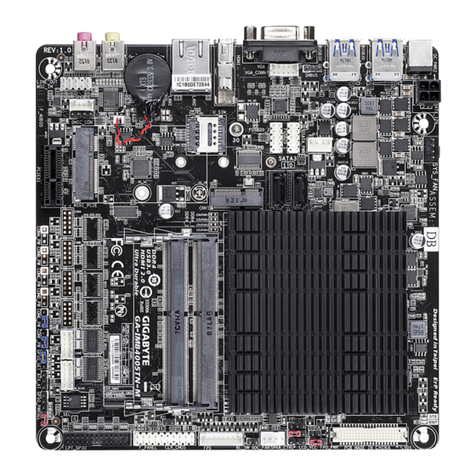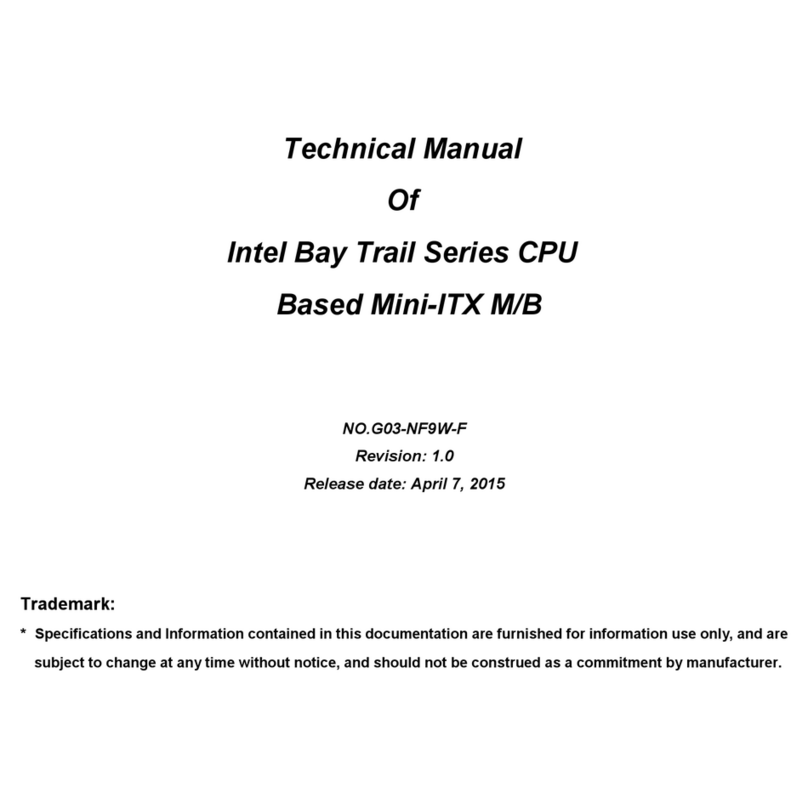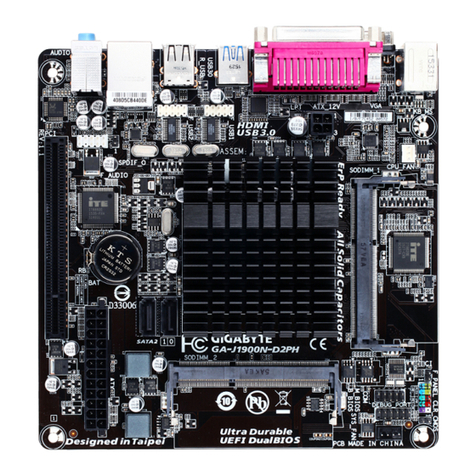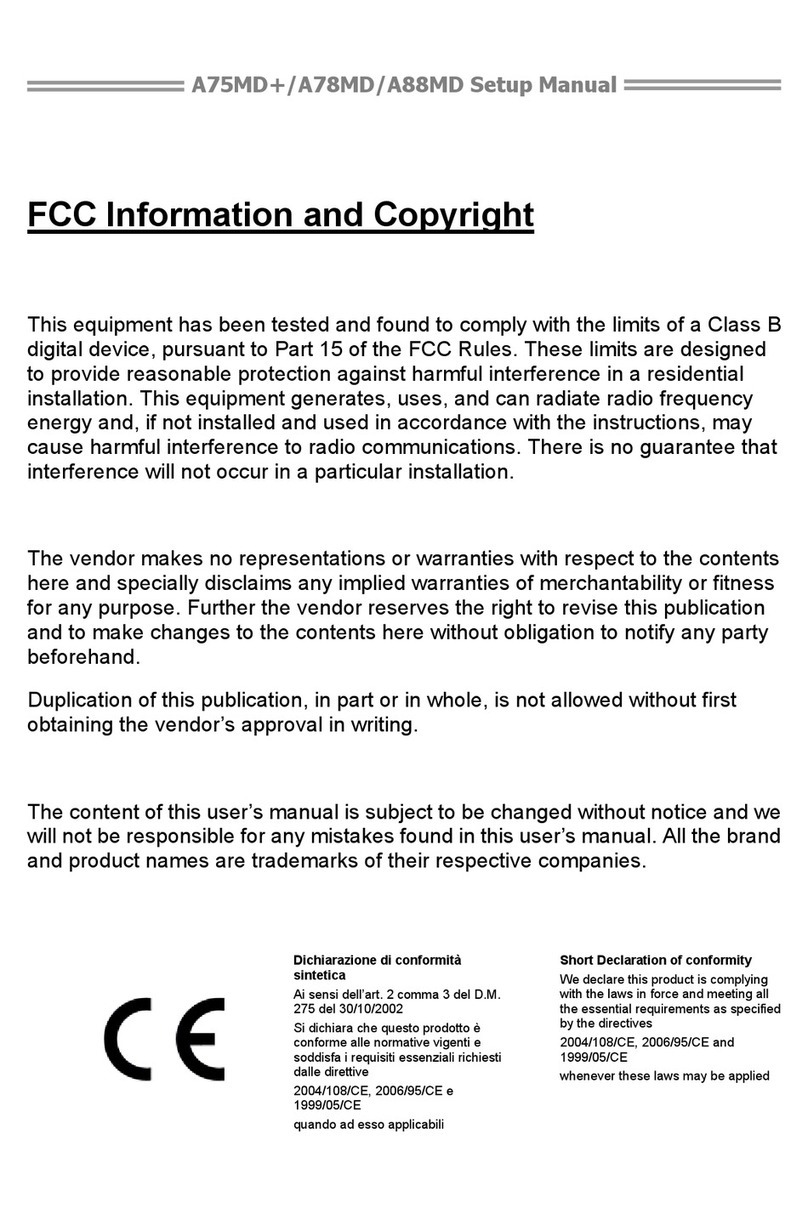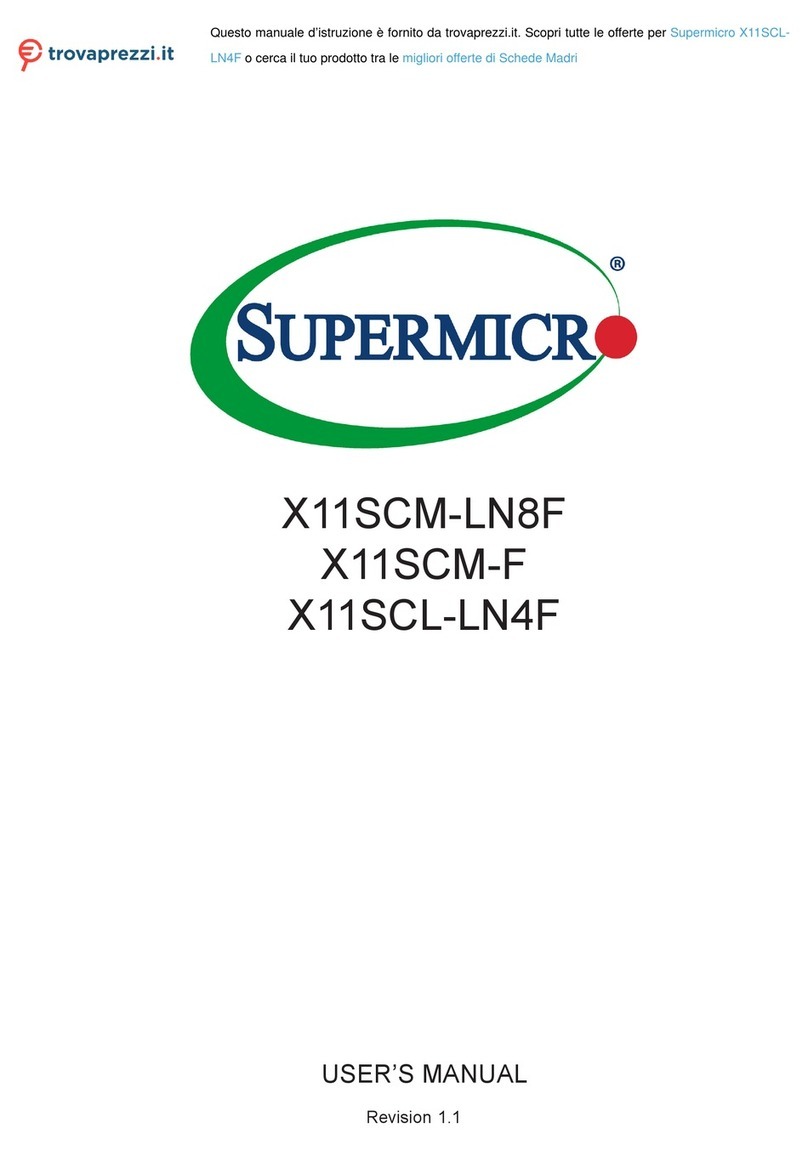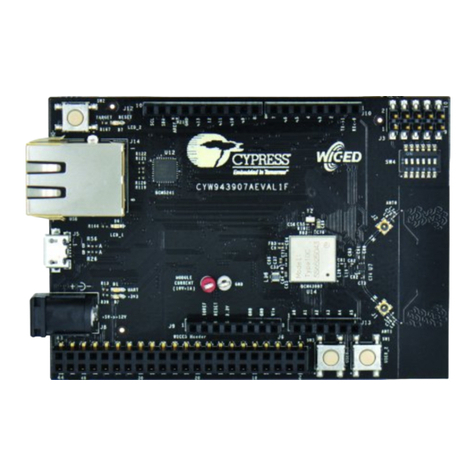IEPC EPC9179 User manual

Evaluation Boards
EPC9179, EPC9180, and EPC9181
Quick Start Guide
Using EPC2252, EPC2218A, and EPC2204A
Revision 2.0

QUICK START GUIDE Evaluation Boards EPC9179/80/81
EPC – POWER CONVERSION TECHNOLOGY LEADER | EPC-CO.COM | ©2023 | For more information: info@epc-co.com | 2
DESCRIPTION
The EPC9179, EPC9180, and EPC9181 are a set of evaluation boards primarily
intended to drive laser diodes with high current pulses with pulse widths
in the single digit nanosecond range, from tens to hundreds of amps.
The high performance is enabled by EPC’s gallium nitride enhancement
mode (eGaN®) FET technology. The boards use the fully automotive
qualied EPC2252 (80 V 75 A), EPC2218A (80 V, 231 A), or EPC2204A
(80 V, 125 A). The boards are accompanied by the EPC9989 interposer
board to provide the user with a simple means of mounting a small set of
commercially available lasers. The EPC9989 has a collection of breakaway
5 mm square interposer PCBs with footprints for dierent lasers and various
alternative loads. The use of the interposers allows many dierent lasers or
other loads to be mounted on the evaluation boards. The boards do not
include a laser diode or load, which must be supplied by the user.
All three boards have the same function and operation, diering only
in peak current and pulse width. Hence, this Quick Start Guide (QSG) will
refer to them collectively by EPC9179/80/81 unless otherwise specied.
The key part of the EPC9179/80/81 is the resonant discharge power stage,
comprising a ground-referenced eGaN FET driven by a Texas Instruments
LMG1020 gate driver. The FET is used to discharge a charged capacitor
through the stray inductance of the load. The eGaN FET enables the use
of a high charging voltage and can turn on in ~1 ns or less, which allows
peak discharge currents to be reached in a few nanoseconds or less.
The printed circuit board is designed to minimize the power loop
inductance and common source inductance while maintaining mounting
exibility for a laser diode or other load. It includes multiple PCB-integrated
high bandwidth passive probes for the simplied measurement of key
circuit voltage and current values, and is equipped with SMA connectors
to provide a high speed connection to instrumentation. In addition, the
user can enable an easily adjustable narrow pulse generator (NPG) capable
of sub-nanosecond precision. As shipped, the board is designed to be
triggered from 3.3 V logic, but is equipped with both a logic level translator
and a dierential receiver (LVDS, CML, LVPECL, etc.) which can be modied
to accommodate dierent use cases. Finally, the board can also be used for
other applications requiring a ground-referenced eGaN FET with ultrafast
switching capability, e.g. Class E ampliers or similar. In addition, footprints
are included on the PCB to simplify the use of some common alternative
laser driving techniques. A simplied block diagram of the circuit is given
in Figure 1.
Additional information on the EPC9179/80/81 is available from EPC at
www.epc-co.com. The full schematics, bill of materials (BOM), and PCB
layout les, along with links to information and datasheets on the EPC2252,
EPC2218A, and EPC2204A AEC-Q101 automotive qualied eGaN FETs can
be found at the following links to the evaluation board product pages:
EPC9179, EPC9180, EPC9181. The datasheets and schematics should
be read in conjunction with this quick start guide (QSG). In addition, EPC
provides an application note: AN027 eGaN FETs for Lidar – Getting the
Most Out of the EPC9126 Laser Driver. While the note discusses the
EPC9126 laser driver, the methods and analysis are directly applicable to the
EPC9179/80/81.
Table 1: Performance Summary (TA= 25°C) EPC9179/80/81
Symbol Parameter Min Nom Max Units
VLogic
Gate drive and
logic supply 5.5 12
VVBUS Pulse charging supply 0
70
VIN Input voltage range
0
5
tPIN Input pulse width 2 ns
FPIN
Pulse input frequency
(does not account for
thermal limitations)
0
Please see Table 2
for maximum
recommended
pulse frequency.
kHz
LASER SAFETY WARNING: This board is capable of driving
laser diodes to generate high power optical pulses. Such pulses
are capable of causing PERMANENT VISION DAMAGE AND
BLINDNESS as well as additional injury or property damage.
Laser diodes may emit infrared (IR) light that is invisible to the
user, but which can still cause PERMANENT VISION DAMAGE
AND BLINDNESS as well as additional injury or property
damage. User is fully responsible for following proper laser
safety procedures to prevent injury or damage.
Figure 1. Block diagram of EPC9179/80/81 development board
RSHUNT
Shunt (J2)
VBUS D1,D2, D3
Optional
VOUT (J3)
PW ADJ (P1)
Cap (J1)
Input select
(J10)
Laser diode or
other load
V3V3
V3V3
V5V0
5V supply
V5V0
VGS
(J6)
RCHRG LSTRAY
CRES
(J4)
VGDIN
(J5)
VLogic (J9)
U1
Q1
+
–
+
–
Narrow pulse
generator
LDO
Enable
Disable
Single-ended (SE)
Input (J9)
Dierential (DIFF)
Input (J11)
3.3V supply
LDO
Table 1 provides the recommended operating conditions for the
EPC9179/80/81. These conditions consider the electrical characteristics of
the unmodied board, and do not take into account thermal limitations,
since the latter depend on the load and use case.

QUICK START GUIDE Evaluation Boards EPC9179/80/81
EPC – POWER CONVERSION TECHNOLOGY LEADER | EPC-CO.COM | ©2023 | For more information: [email protected] | 3
MAIN FEATURES
• High current pulse generation with nanosecond pulse width
• Integrated high bandwidth measurements for key waveforms
• Optional narrow pulse generator to simplify operation with typical pulse
and function generators
• Single-ended or dierential logic inputs
OPERATING PRINCIPLE
The EPC9179/80/81 is intended as both a evaluation board and a exible
development platform. It is functional out of the box, but is designed to
be modied to accommodate a broad range of applications. It is highly
recommended that the user read the entire guide, especially the section
ADDITIONAL FEATURES, in order to get maximum value from the
EPC9179/80/81.
The EPC9179/80/81 is shipped as a resonant capacitive discharge
laser diode driver. Please refer to the block diagram (Figure 1) and the
schematic corresponding to the board of interest. It has several possible
modications (section ADDITIONAL FEATURES), but only the basic
operation will be covered in this section. The EPC9179/80/81 operating
principle is to charge the energy storage capacitance CRES comprised of
{C2, C3, C4, C5, C6 } through the resistor RCHRG comprised of {R4, R5, R6,
R7}, and when triggered, discharge CRES through inductance LSTRAY and
the laser diode or load U1. The stray inductance LSTRAY is a simplied
representation of the total parasitic inductance of the power loop, and
it is not a component mounted to the PCB. The capacitance CRES and the
inductance LSTRAY form the resonant network. Please see AN027 eGaN
FETs for Lidar – Getting the Most Out of the EPC9126 Laser Driver for
a complete description of resonant discharge laser driver operation.
The trigger pulse can be controlled from two dierent inputs. As shipped,
it is controlled via an input pulse that is delivered to SMA connector
J9, which is terminated on the demo board with 50 Ω. Input J9 feeds a
level translator U7, and the output of the level translator is passed to an
input select jumper J10. This pulse PLS_IN is passed to the input of the
narrow pulse generator (NPG). When the input goes high, the output of
the NPG follows, feeding the gate driver U3 which turns on Q1, allowing
CRES to discharge through the laser diode U2. If the NPG is disabled, then
when the input goes low, Q1 turns o. If the NPG is enabled, the user can
get a short gate drive output pulse to the lower limit of the gate drive
IC U3’s capability. This allows the use of lower cost signal generators
while working with the EPC9179/80/81. Details are given in Section
ADDITIONAL FEATURES.
Once CRES is discharged, Q1 should be turned o. Now, CRES will recharge
through RCHRG. Once it is fully charged, the circuit can be red again.
DIFFERENCES BETWEEN THE EPC9179, EPC9180,
and EPC9181
The EPC9179, EPC9180, and EPC9181 evaluation boards are nearly
identical in function, design, and layout. The key dierence between
the boards is the eGaN FET used for Q1. The FETs are selected to
cover a wide range of peak pulse currents, with the larger FETs
enabling higher peak currents. The primary tradeo for the ability to
reach higher peak currents is increased minimum pulse width. The
combination of higher peak current and increased pulse width results
in the need for increased resonant capacitor values and a reduced
current measurement shunt value, along with a change to the latter’s
ESL compensation capacitor. Table 2 gives a comparison of the three
evaluation boards in order to highlight the dierences.
It is recommended that the user choose the smallest FET that will
meet the peak current needs. This will give the shortest possible pulse
while still meeting the peak current requirements. The pulse width
can be increased by increasing the value of the resonant capacitor.
Table 2. Comparison of the EPC9179, EPC9180, and EPC9181
evaluation boards
Parameter
Description EPC9179 EPC9180 EPC9181 Units
Q1FET part number EPC2252 EPC2218A EPC2204A n/a
CRES
(C2-C6)
Eective total
resonant
capacitance
1.1
10.8 3.4 nF
RSHUNT
(R12-R16)
Eective total
resonant current
shunt resistance
102 30
60
mΩ
C7
Shunt
compensation
capacitance
12
36 18
pF
IPeak
Nominal peak
current for ideal
diode load
75 230 125 A
TPW
Nominal pulse
width for high
performance SMT
laser diode
2-3 5-6 3-4 ns
TCHRG
CRES charge time to
0.98 VBUS with ideal
diode load
1.7 17 5.3 μs
FMAX
Max pulse rate
based on 1/TCHRG
(does not account
for any thermal
limitations)
590 59 190 kHz

QUICK START GUIDE Evaluation Boards EPC9179/80/81
EPC – POWER CONVERSION TECHNOLOGY LEADER | EPC-CO.COM | ©2023 | For more information: [email protected] | 4
Figure 2. Output terminals of the EPC9179/80/81
Figure 3. EPC9989 interposer PCB for mounting dierent lasers and loads
Top
Bottom
SMD lasers MMCX Alternate loads
Breakaway
V-grooves
Laser cathode
(FET drain)
Laser anode
(FET drain)
GND (for alternate
applications)
LASER DIODE OR LOAD CONSIDERATIONS
The EPC9179/80/81 has a set of pads which can be used as is to mount a
laser diode or alternative load. Figure 2 highlights the output pad locations.
However, many laser suppliers have dierent mounting footprints, making
it dicult to optimize the performance of the driver and still maintain the
desired exibility. The use of an interposer PCB provides a solution to this
problem with only a small impact to performance.
The EPC9179/80/81 ships with the EPC9989 interposer PCB, shown in
Figure 3. The EPC9989 has an assortment of 5 x 5 mm square interposer PCBs
that can be snapped o the board. These interposers have various footprints
on thetopside that can accommodateseveral surfacemount laser diodes, RF
connectors, and several patterns designed to accommodate a wide variety
of possible loads. These interposers mount between the EPC9179/80/81
and the laser diode or other load. Figure 4 shows an example of a laser in an
SMD package mounted with one of the interposers.
The following procedure can be used to hand mount a laser diode or other
load using the interposer. It is recommended that the person doing this
work be experienced in hand rework of SMT components.
1. Prepare the EPC9179/80/81 by removing the jumpers on J4 and J10 so
that they do not deform during reow soldering. Use best practice to
avoid electrostatic discharge (ESD) damage to the laser diode or other
load, or to the EPC9179/80/81, during the following steps. Laser diodes
are often extremely sensitive to ESD damage.
2. Select the interposer with the top side that ts the desired load.
3. Apply solder paste to the appropriate pads on the top side of the
interposer.
4. Place the laser diode or desired load on the interposer such that the pads
of the load line up with the matching pads on the interposer. Set this
assembly gently aside, taking care not to bump it or displace the load
since the solder paste is still soft.
5. Apply solder paste to the U1 pads on the EPC9179/80/81 PCB.
6. Using tweezers or other means, pick up the assembly of the interposer
and laser or alternative load that was set aside in Step 4. Carefully position
the assembly with the bottom side of the interposer facing the top side
of the EPC9179/80/81 on the U1 footprints and set in place.
7. Reow the EPC9179/80/81 together with the interposer-load assembly
using the laser or load manufacturer’s recommended temperature
prole for the selected solder. The use of a reow oven that can meet the
recommended soldering specications is highly recommended. Other
reow methods may also be used based on the experience of the user,
but it should be noted that many lasers have a polymer optical assembly
that is sensitive to overheating.
8. Replace jumpers on J4 and J10.
The power loop inductance, including that of the laser diode, is a primary
factor that determines the shape of the laser pulse. Considerable eort
has been made to minimize power loop inductance while maximizing
the choice of laser diode and its orientation. Maxwell’s Laws dictate that
the discharge capacitors, current sense resistors, and the eGaN FET must
all be mounted in close proximity to minimize inductance. The resulting
proximity of all these components to the laser or other load means that the
user must take extra care not to damage any components when mounting
the laser or changing other components in the power loop.
The schematic and layout les for the EPC9989 interposer can be found
on the main information pages for the EPC9179/80/81. In addition, a
PCB footprint is available so that the user may design their own custom
interposer.
Laser diode current pulses can result in peak powers of several hundred
watts to over 1 kW. Laser diodes for lidar applications are designed with this
in mind, but thermal limitations of the laser package mean that pulse widths,
duty cycles, and pulse repetition frequency limitations must be observed.
Read laser diode data sheets carefully and follow any manufacturers’
recommendations.
Laser diode
or load
EPC9989
interposer
eGaN FETGate driver
Current shunt
Resonant
capacitors
Recharging
resistors
L
Figure 4. Laser diode mounted with EPC9989 interposer

QUICK START GUIDE Evaluation Boards EPC9179/80/81
EPC – POWER CONVERSION TECHNOLOGY LEADER | EPC-CO.COM | ©2023 | For more information: [email protected] | 5
MEASUREMENT CONSIDERATIONS
SMA jacks are provided to measure key signals in the circuit, including
gate drive IC input, Q1 gate voltage, Q1 drain voltage, resonant capacitor
CRES voltage, and the sense voltage of the current measurement shunt
(see Figure 5). All measurement points are designed to be terminated in
50 Ω, hence when viewing waveforms, the oscilloscope inputs should
be set to a 50 Ω input. Ideally, unused outputs should be also terminated
with a 50 Ω load to prevent the probes from creating additional
resonances. However, the Q1 drain voltage VOUT, the discharge capacitor
sense voltage CAP, and the current shunt output SHUNT also have
impedance values relatively close to 50 Ωs as seen from the SMA
connector. Thus, the reection coecient is small and in practice, the
subsequent resonances are small if these are left unterminated. It is
recommended that the user verify that this is suitable for their own
requirements.
All sense measurement SMA connectors except for the shunt
measurement use the transmission line voltage probe principle
to obtain waveform delity at sub-ns time scales. They have been
veried to produce near-identical results to a Tektronix P9158 3 GHz
transmission line probe. As a result of their design, they have a built-in
attenuation factor. These factors are given in Table 3. The impedance of
the probes at the measurement node is relatively small (~1 kΩ). In order
to minimize the eects of the low probe impedance on the operation of
the demo board and prevent overheating of the probe input resistors,
the output voltage (J3) and capacitor voltage (J1) probes have DC
blocking capacitors on the PCB. As a result, measured pulse waveforms
will not have any DC component and will exhibit droop as pulse widths
and other waveform features approach the RC time constant of the
probe. The user should keep these factors in mind if accustomed to
more conventional oscilloscope probes. If long pulse widths are used,
the droop will become substantial, and an external probe may be used
to measure these slower waveforms more accurately.
The current shunt is designed to estimate the discharge capacitorcurrent.
Substantial eort has been made to reduce the inductive eects of the
current shunt, both through the use of carefully selected resistors and
a compensation network to help compensate for the shunt equivalent
series inductance. However, the shunt is a compromise between current
measurement accuracy and minimizing the impact on the laser driver
performance. If a more accurate shunt waveform measurement is
desired, the shunt resistors may be replaced with ones that provide
higher accuracy at the bandwidth required. This will require higher
resistor values which will contribute to errors in the capacitor voltage
measurement, increase power dissipation, and reduce the available
peak current for a given bus voltage VBUS. Additionally, note that the
measured capacitor current also includes the current due to D1, D2, and
D3 (if included), and PCB capacitance, in addition to the load current.
Finally, when one wishes to understand detailed switching behavior, it
is important to consider the timing mismatch of the probe point. The
approximate delay times have been calculated based on the assumption
that a 50 Ω transmission line connects the SMA to the test point of
interest, neglecting the eects of passive component pads. They are
listed in Table 3.
Table 3: Key properties of SMA measurement outputs assuming 50 Ω terminations on measurement instruments
Designator PC label Description Attenuation
factor
PCB propagation
delay (calculated)
DC blocking
cap
DC blocking LF
time constant
On-PCB
termination
J1 CAP Resonant capacitor voltage 41 V/V 119 ps 10 nF 10 ms YES
J2 SHUNT Resonant capacitor current
measurement
19.6 A/V (EPC9179)
66.7 A/V (EPC9180)
33.3 A/V (EPC9181)
116 ps none
n/a YES
J3 VOUT Q1 drain voltage
41 V/V 118 ps 10 nF 10 μs
YES
J5 VGDIN Gate drive IC (U3) input voltage
20 V/V 163 ps none n/a
NO
J6 VGS Q1 gate voltage
20 V/V 171 ps none n/a
NO

QUICK START GUIDE Evaluation Boards EPC9179/80/81
EPC – POWER CONVERSION TECHNOLOGY LEADER | EPC-CO.COM | ©2023 | For more information: [email protected] | 6
QUICK START PROCEDURE
The EPC9179/80/81 evaluation board is simple to set up for evaluation of
the performance of the EPC2252, EPC2218A, and EPC2204A eGaN FETs.
NARROW PULSE GENERATOR
Many signal generators cannot produce an accurate, short pulse with
sub-ns edges. The EPC9179/80/81 includes a narrow pulse generator
(NPG) function to obtain narrow output pulses of adjustable width,
following a method given in Section 8.2.2.2 of the Texas Instruments
LMG1020 data sheet. The pulse width is controlled through
Potentiometer P1. When adjusting P1, the use of a non-conductive
tool is recommended due to the sensitivity of the adjustment to stray
capacitance.
The NPG is enabled by moving the jumper on J4 to the leftmost
position (see Figure 6). With the NPG enabled, the input pulse signal is
split into separate turn-on and turn-o paths. The turn-on path goes
through buer U2, a xed RC delay {R23, C14} and buer U4 on to the
IN+ (non-inverting) input of gate driver U3, which turns output Q1 on.
The turn-o path is similar, but has an adjustable RC delay {P1, R27,
C16}. This delayed pulse is sent to the IN- (inverting) input of U3. The
longer delay of the second path means that after some interval, the IN-
input of U3 goes high, and Q1 is turned o, ending the output pulse.
The procedure in this section provides basic instructions to operate the
boards in the default (as shipped) conguration. Refer to Figure 2 for proper
connection and measurement setup and follow the procedure below:
1. Review laser safety considerations when using a laser load.
Observe all necessary laser safety requirements including the use
of personal protection equipment (PPE) as required. Review high
voltage safety considerations since the evaluation boards may
operate with voltage levels that may present a safety hazard. Refer
to qualied safety personnel as necessary.
2. With power o, install laser diode U1 or alternative suitable load.
The use of one of the interposers from the included EPC9989 can be
used to mount the laser or alternative load. This is discussed in the
section LASER DIODE OR LOAD CONSIDERATIONS.
3. With power o, connect the main power supply to VBUS (J8), taking care
to observe the correct polarity.
4. With power o, connect the logic supply (5.5-12 VDC) VLogic (J7), taking
care to observe the correct polarity.
5. With power o, connect the signal pulse generator to the input J9. J9 is
terminated with 50 Ω, and is designed for a 3.3 V logic input as shipped.
Ensure that the pulse repetition frequency is within the recommended
range.
6. Connect the remaining measurement SMA outputs to an oscilloscope,
using 50 Ω cables and with the scope inputs set to 50 Ω impedance.
See section MEASUREMENT CONSIDERATIONS for more information,
including the attenuation values for each output.
7. Verify that the logic supply voltage is set to a value within the
specications and turn on the logic supply voltage.
8. Verify that the bus supply voltage is set to a value within the specica-
tions and turn on the bus supply voltage.
9. Turn on the pulse source and observe switching operation via the
outputs and any additional desired probing. Laser diode output may be
observed with an appropriate opto-electronic receiver.
Laser diode
or load
VLogic VBUS
Note polarity
Signal generator
Oscilloscope
(50 Ω inputs)
– +
+ –
Figure 5. Connection and measurement setup
10. Once operational, adjust the bus voltage, input pulse width, and
pulse repletion frequency (PRF) as desired within the operating
range and observe the system behavior.
11. For shutdown, please follow steps in reverse.
ADDITIONAL FEATURES
The EPC9179/80/81 is designed to accommodate a range of use
scenarios. Some of these are available with no modications to the
PCB. The locations of key adjustments are indicated in Figure 6.
Advanced features require the ability to remove and replace SMT chip
components. It is recommended that these are done by qualied
personnel with experience in SMT rework.
When reading this section, please have the full schematic available for
reference.
LVDS input
from J11
Single-ended
input from J9
(default)
NPG pulse width
adjustment
NPG enabled
Dierential input Single-ended input
NPG disabled (default)
Figure 6. Location of key features and adjustments

QUICK START GUIDE Evaluation Boards EPC9179/80/81
EPC – POWER CONVERSION TECHNOLOGY LEADER | EPC-CO.COM | ©2023 | For more information: [email protected] | 7
Potentiometer P1 is used to adjust this turn-o delay and the resulting
output pulse width, with clockwise rotation increasing the pulse width
applied to the gate of Q1. Note that the minimum delay setting causes
both turn-on and turn-o paths to have an approximately equal delay,
which would result in a zero-width pulse. Since the gate driver U3 has a
minimum pulse width specication of > 1 ns, it is U3 that determines the
minimum attainable output pulse width. Small errors in the delay path
do not signicantly impact the output. The maximum pulse width that
can be obtained with the NPG is approximately 60 ns, so if longer pulses
are needed, the NPG should be disabled.
When using the NPG, it is recommended that the input pulse should be
at least 10 ns longer than the desired output pulse to guarantee reliable
operation under all ambient conditions.
ADVANCED FEATURES
The EPC9179/80/81 has the option to be controlled from a dierential
input. As shipped, this input is congured for standard LVDS signals.
It input is available to the user through the 8-pin header J11. Table 4
shows the pinout for J11, which also provides alternate access to some
of the power supply voltages on the board. In order to enable the LVDS
or other dierential input, move the jumper on J10 to the upper position
(Figure 6).
LVDS AND ALTERNATE INPUTS
The following features require modications to the board.
Load Clamping diodes
Empty component footprints are present on the EPC9179/80/81 to allow
the user to mount up to 3 clamp diodes (D1, D2, D3). While such diodes
can provide some protection to FET Q1 and laser or load U1, they have
parasitic inductance and capacitance that can reduce performance.
In addition, they clamp the laser or load reverse voltage and this can
reduce turn-o speed. Hence, they are not populated, and it is left to the
user to determine whether they are useful for a particular application.
Eye safe operation
In some applications, it is required that the driver remain eye-safe in
the event of a failure causing Q1 to be on in an uncontrolled manner,
e.g. an erroneous gate drive signal or FET short. While the charging
resistance provides some current limiting, it may not be enough. In
such a case, R8 can be removed, and at least one of the clamp diodes
D1, D2, or D3 populated. Once this is done, the capacitor bank will
be charged through the charging resistance and the clamp diode(s).
However, if Q1 is on, the charging current will now ow through Q1
and not the laser diode, preventing any light output.
Fast Refresh
The value of the energy storage cap {C2, C3, C4, C5, C6} can be modied
as desired, as well as the recharge resistor {R4, R5, R6, R7}. In the extreme
case, the resistor may be reduced to 0 Ω for cases where a capacitive
discharge pulse is not desired. The latter can also be accomplished
by populating R1. If this approach is taken, it is recommended that R1
have some small value of resistance (5 Ω to 20 Ω) to damp possible
resonances in the power bus.
Logic input level and type
The input specication of the demo board may also be modied. For
single-ended inputs, the input logic level can be reduced from 3.3 V
logic to 2.5 V or 1.8 V by changing R37. Please see the U7 datasheet for
further details. If a dierential input dierent than LVDS is desired, the
dierential receiver U8 can accommodate sub-LVDS, CML or LVPECL
signals by changing the values of U8’s input termination network.
Please see the U8 datasheet for further details.
Improving laser cooling
Some pulse laser applications are thermally limited by laser power
dissipation. Usually, the laser die substrate forms the cathode, which is
attached to the drain of Q1. Since this terminal is the most electrically
active terminal in the whole circuit, it must be kept small and electrically
isolated from anything else in the circuit. This makes it dicult for heat
to ow out of the laser. This terminal is connected to a small copper
land on the bottom of the PCB with a thermally conductive via array.
Hence, the thermal resistance from the laser cathode to the bottom
thermally conductive ground plane of the PCB can be reduced by
populating R17, R18, R19, and R20. The high electrical resistance of these
parts means they have negligible electrical eect, but the thermal
resistance of the chip resistors is much lower than the PCB substrate.
Note that thermal performance can be further improved with the use
of thermal bridges, which are essentially a blank resistor chip made
with an aluminum nitride body for enhanced thermal performance.
Table 4. J11 Pin Description
J11 Pin Description Schematic Net Name
1Not connected N/A
2Internal 5 V supply V5V0
3Logic supply Vlogic
4Internal 3.3 V supply V3V3
5Ground GND
6Non-inverting dierential input IN_D+
7Ground GND
8Inverting dierential input IN_D-

QUICK START GUIDE Evaluation Boards EPC9179/80/81
EPC – POWER CONVERSION TECHNOLOGY LEADER | EPC-CO.COM | ©2023 | For more information: [email protected] | 8
PERFORMANCE EXAMPLES
Figures 7, 8, and 9 show typical waveforms for the EPC9179, EPC9180, and EPC9181 demo boards, respectively. In all cases, the waveforms were
obtained with VBUS = 70 V at room temperature.
Figure 7. Waveforms for the EPC9179 demo board using an ams OSRAM SPL S1L90A_3 A01 single channel triple junction laser diode mounted with the EPC9989 interposer.
Figure 8. Waveforms for the EPC9180 demo board using an ams OSRAM SPL S4L90A_3 A01 four channel triple laser diode mounted with the EPC9989 interposer.
All channels are connected in parallel.
Figure 9. Waveforms for the EPC9181 demo board using an ams OSRAM SPL S4L90A_3 A01 four channel triple laser diode mounted with the EPC9989 interposer.
All channels are connected in parallel.
VOUT (vDS),
10 V/div
VCAP,
20 V/div
SHUNT (iLASER)
19.4 A/div
2 ns/div
VGS, 1 V/div
Pulse width: 1.96 ns
Peak current: 63.1 A
5 ns/div
Pulse width: 5.59 ns
Peak current: 223 A
VOUT (vDS),
10 V/div
VCAP,
20 V/div
SHUNT (iLASER)
50 A/div
VGS, 1 V/div
2 ns/div
Pulse width: 3.16 ns
Pulse width: 3.16ns
Peak current: 135A
SHUNT (iLASER)
19.4 A/div
VGS, 1 V/div
VOUT (vDS),
10 V/div
VCAP,
20 V/div

Evaluation Board Notication
The EPC9179/80/81 boards are intended for product evaluation purposes only. They are not intended for commercial use nor is it FCC approved for resale. Replace
components on the Evaluation Board only with those parts shown on the parts list (or Bill of Materials) in the Quick Start Guide. Contact an authorized EPC representative with any questions.
This board is intended to be used by certied professionals, in a lab environment, following proper safety procedures. Use at your own risk.
As an evaluation tool, this board is not designed for compliance with the European Union directive on electromagnetic compatibility or any other such directives or regulations. As board builds
are at times subject to product availability, it is possible that boards may contain components or assembly materials that are not RoHS compliant. Ecient Power Conversion Corporation (EPC)
makes no guarantee that the purchased board is 100% RoHS compliant.
The Evaluation board (or kit) is for demonstration purposes only and neither the Board nor this Quick Start Guide constitute a sales contract or create any kind of warranty, whether express or
implied, as to the applications or products involved.
Disclaimer: EPC reserves the right at any time, without notice, to make changes to any products described herein to improve reliability, function, or design. EPC does not assume any liability
arising out of the application or use of any product or circuit described herein; neither does it convey any license under its patent rights, or other intellectual property whatsoever, nor the rights
of others.
EPC Products are distributed through Digi-Key.
www.digikey.com
For More Information:
or your local sales representative
Visit our website:
www.epc-co.com
Sign-up to receive
EPC updates at
bit.ly/EPCupdates
or text EPC to 22828
This manual suits for next models
2
Table of contents
Other IEPC Motherboard manuals
